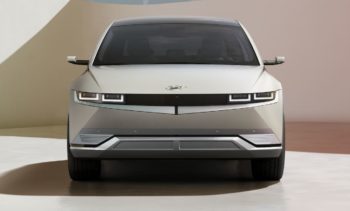Update: ‘Features’ section updated with more information in ‘Advanced Infotainment System’ subsection.
The Ioniq 5 and Ioniq 6 will be followed by a new flagship Hyundai electric vehicle called the Ioniq 7. During the launch of the Ioniq 5 in the U.S. market, the company said that the Hyundai Ioniq 7 SUV will be launched in 2024, following the Ioniq 6 sedan this year.
Speaking at the Ioniq 5 launch last year, Jose Munoz, President & CEO, Hyundai Motor North America, confirmed that the Hyundai Ioniq 7 will be a three-row fully electric mid-size SUV.
The launch of the Ioniq 5 compact CUV will be followed by the stunning Ioniq 6 mid-size sedan in next year, which subsequently will be followed by the three-row mid-size SUV Ioniq 7 in 2024. This is just the beginning, for Hyundai will be introducing 23 battery electric vehicles across the globe by 2025.
Jose Munoz, President, and CEO, Hyundai Motor North America
Announcing the Ioniq brand for the future Hyundai electric vehicles and its initial line-up in August 2020, Hyundai had revealed that the Ioniq 7 would be a large SUV. Like the other Ioniqs, it will use the new platform developed exclusively for next-gen Hyundai Motor Group electric vehicles – E-GMP (Electric-Global Modular Platform). It underpins future Kia EVs (including the Kia EV6) and the first dedicated Genesis EV, the Genesis GV60 launched in S. Korea in October 2021.
Design
The Ioniq 7 will be derived out of the Hyundai Seven Concept showcased at the 2021 Los Angeles Auto Show. The Seven brings together a traditional SUV body with a boxy silhouette and futuristic design language.
The large electric SUV wears a sleek LED DRL strip that runs across the width of the bonnet line. There is a massive grille area under the bonnet with an illuminated light function when the vehicle is turned on. The vertically stacked LED headlamps are located on each corner of the bumper with a silver skid plate. The clamshell bonnet design and upright stance impose the size of the big electric SUV.

The sides sport a straight window line with a roof that slopes towards the rear. The 5-spoke alloy wheels surrounded by squared wheel arches maintain a rugged SUV character. Other interesting bits on the sides include pillar-less door frames along with sleek windows. The rear is as unique as the front. The tailgate is made out of the glass with Parametric Pixel lights taking over the rear as well.
Simon Loasby, Head of Hyundai Style Group, Hyundai Motor Group talked about the Seven concept’s design with Car And Driver in November 2021. He mentions that the Ioniq 7 will borrow the Seven’s Parametric Pixel Lights but the production-spec SUV will feature a flat and translucent cover over the pixel-shaped lights to aid practicality, whereby dust and snow are not accumulated. He also confirms that the all-glass tailgate of the Seven Concept will not make it to the final version.
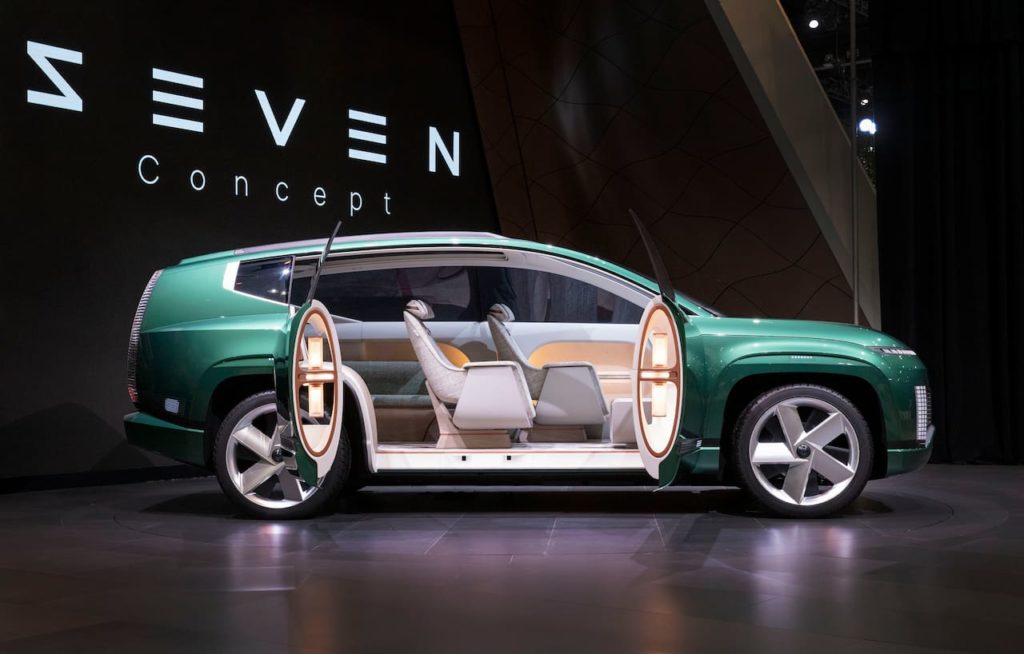
On the inside, the Seven Concept houses a lounge-like seating arrangement with swivelling lounge chairs, a lounge bench, retractable driver seat. The highlight of the cabin has to be the Vision Roof Display featuring a panoramic OLED screen that displays content as per the occupants’ preference. Other noticeable features include a 27-inch display, an airplane-like air purification system, generous use of eco-friendly materials like bamboo wood, mineral plaster, bio-resin and more. The production version would be a three-row electric SUV (confirmed), likely with 6- and 7-seat seating options offering best-in-class knee room and headroom.
Car and Driver has been told that a lot of the concept’s interior elements will not make it to the production variant save for capsule-shaped cut-outs in the door panels. However, a lot of the design elements from this concept can make it to production and the final version will be true to the concept, said Jose Munez, CEO of Hyundai Motor Group to Motor Trend.

Specifications
As revealed by Hyundai during the launch of the Ioniq 5 (reported by Carscoops), the company plans to use a 100 kWh battery pack that can deliver a range of 300 miles (483 km) in the Ioniq 7 (EPA-estimated). Drivetrain layout choices will include two-wheel drive and all-wheel drive, and the AWD configurations will have two motors producing a net power of 230 kW (313 PS/308 bhp). A ground clearance of more than 8 inches is expected for the Ioniq 7.
Hyundai won’t be ready with a solid-state battery for mass production before 2027. However, the company does plan to improve the energy density of its current Lithium-ion battery cells from early 600 Wh/L to mid-700 Wh/L in 2025. The Ioniq 7 would be among the first models to benefit from the new version of Lithium-ion batteries, sourced from SK Innovation – Hyundai’s partner for EV battery packs over ten years now.
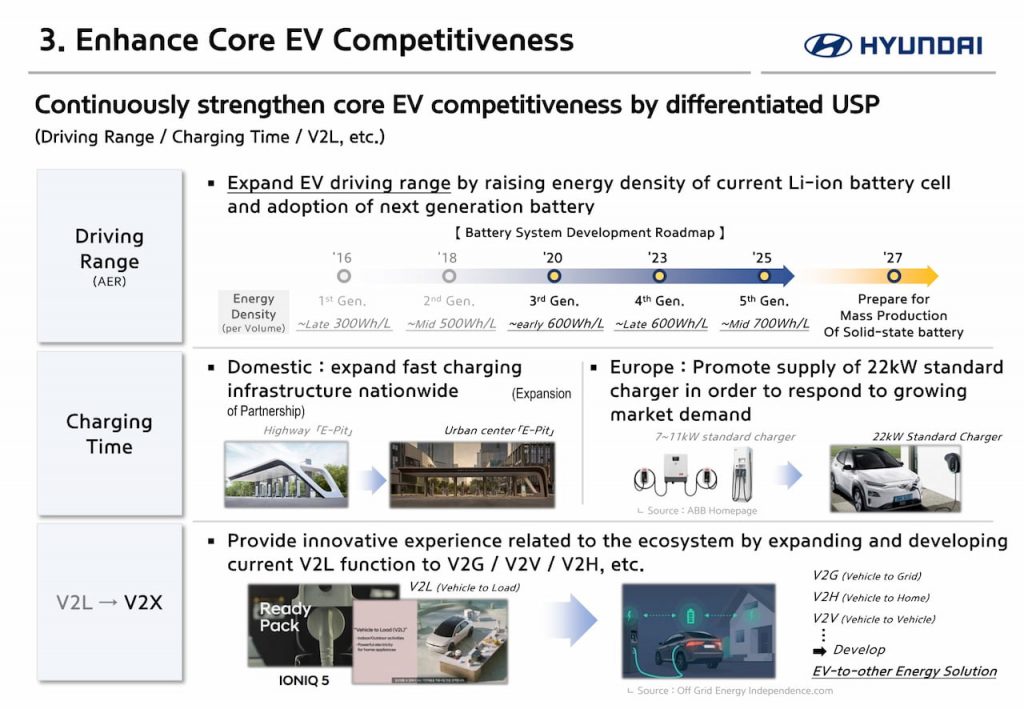
On the charging front, the Ioniq 7, like the 5, will be capable of at least 350 kW (800V) fast charge thanks to the onboard system, which supports 400V and 800V without the need for additional adapters. In this setup, 80% charging time is just 18 minutes, an experience similar to refuelling.
Features
Coming back to the production Ioniq 7, hopes are high that Hyundai will pack the electric SUV with segment-first features, some of the expected ones of which are as follows:
Level 3 autonomous driving system
Hyundai’s autonomous driving technical roadmap confirms that Level 3 hands-free autonomous driving will come this year with the ‘Highway Driving Pilot.’ In Level 3, “the car is able to manage safety functions under certain conditions, but the driver is expected to take over when alerted.” The Ioniq 7 should become a beneficiary of this feature.
Wireless charging
Thanks to a possible ground clearance of more than 8 inches, the Hyundai Ioniq 7 will have enough room below its floor for wireless charging through a transmission unit. Hyundai has already confirmed that wireless charging for models underpinned by the E-GMP platform is under development. A pilot program launched this year with the Genesis GV60 in South Korea would decide the progression of this technology.
Use of high-tech and recycled materials

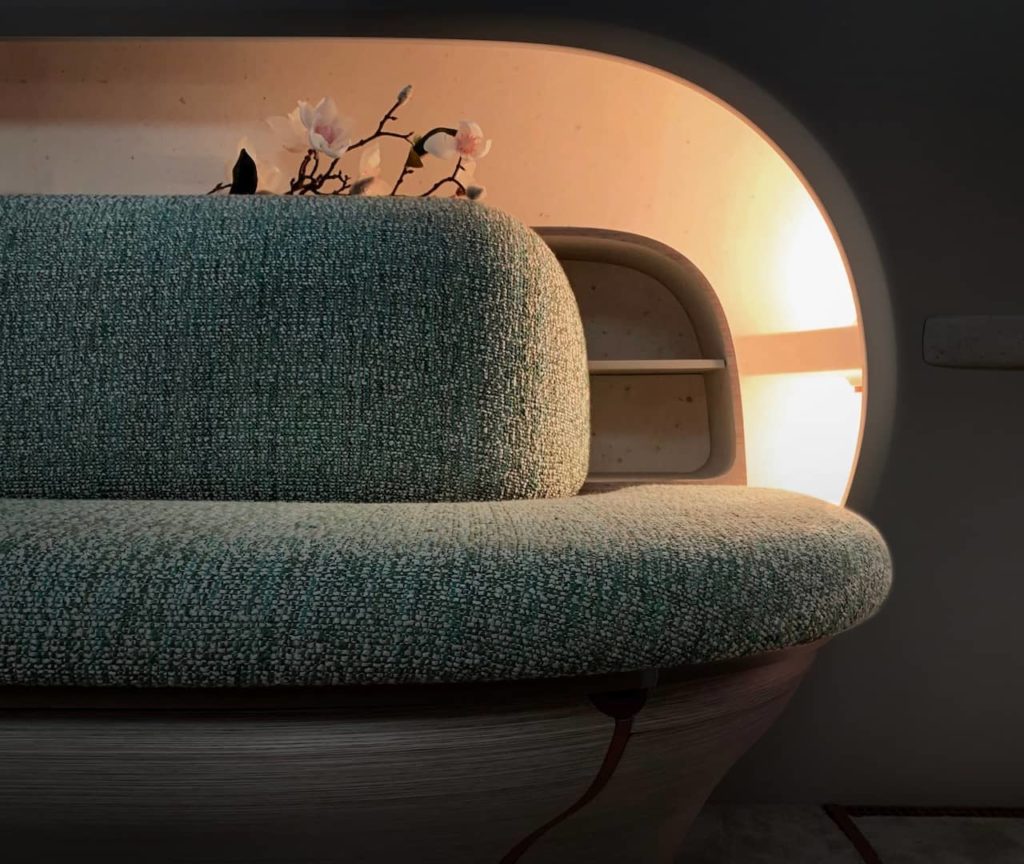
The premium positioning of the Ioniq 7 might allow Hyundai to use high-tech materials for paints and trims, which will come with added functionality over aesthetics. According to a conversation between Luc Donckerwolke, Chief Creative Officer, Hyundai and Autocar, the company is working on this technology, which might be functional by mid-decade. Also, various bits inside the car, including seats, armrest, floor, and door, can be made with eco-friendly recycled plastics, plant-based (bio PET) yarns and natural wool yarns, bio paint with plant extracts, and artificial leather with plant-based extracts.
Advanced infotainment system
The Hyundai Ioniq 7 is one of the upcoming cars from HMG to launch from 2022 to come equipped with a new ‘NVIDIA DRIVE’ connected car platform in their infotainment systems. With the help of a hardware and software stack, the NVIDIA DRIVE can merge audio, navigation, and connected car services for a more optimized and advanced user experience in sync with Hyundai’s in-house connected car operation system (ccOS) through a digital cockpit.
The ccOS will use NVIDIA’s software frameworks leading to a technologically advanced cabin. Moreover, the Ioniq 7 will not get Ioniq 5’s Bluelink connected car system. This report from Maeil Economic Daily dated January 17, 2022, suggests that HMG is planning to merge the connected car systems of its subsidiaries (Hyundai Bluelink, Kia Uvo and Genesis Connected) into one feature-intensive package. Although, there’s no timeframe as to when this project will come to fruition.
Additionally, Pulse News reported on January 18, 2022, that connected car features have become a decisive aspect in people’s car-buying decisions and HMG won’t take long to launch its integrated connected car service. HMG has a goal of securing 10 million connected car service users this year, with the service already present in the USA, Canada, China, India, Russia, Europe, and Korea, and plans to expand to more countries.
Generally, connected car features allow owners to remotely control — through a smartphone app — various functions of their car like lock/unlock, remote ignition start, pre-heating or ventilation, geo-fencing and more. It will be interesting to see what HMG brings to the table with the integration of the three platforms.
Digital key
A Digital Key that is downloaded to the owners’ smartphone and operates via the app. Apart from the current functionalities of unlocking and starting the vehicle through a smartphone application, Hyundai’s digital key for Ioniq 7 might come with advanced features such as automatically unlocking the car sensing the proximity of the user after a specific time period.
V2L (Vehicle to load)
This feature has already made its debut in the Ioniq 5 and will make its way into the Ioniq 7. By this feature, one can use the electrical energy stored in the battery pack of the vehicle to run appliances and even replenish the battery of other EVs.
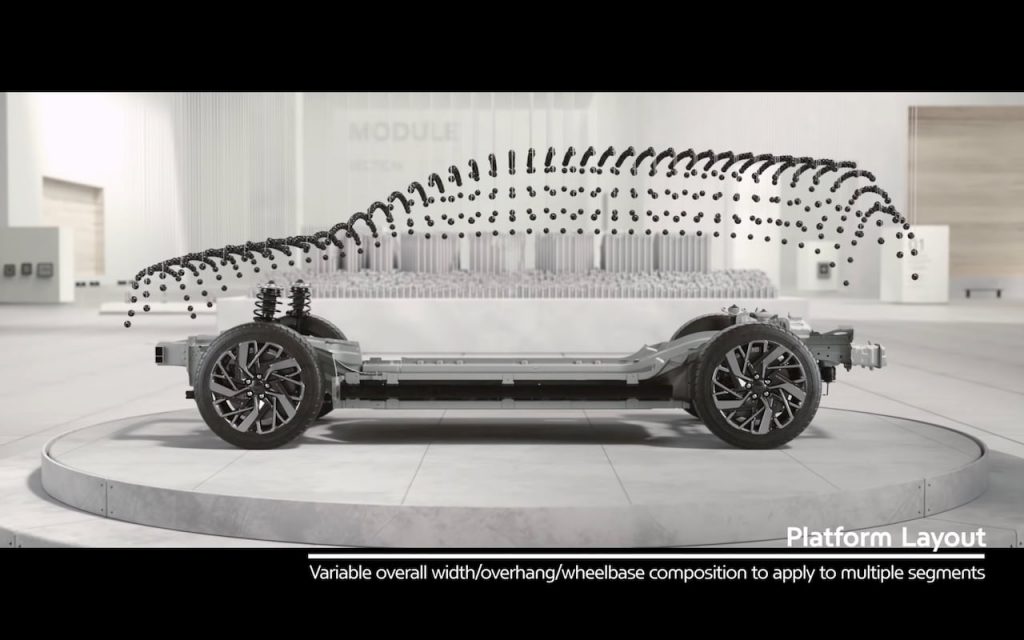
Vision roof
For the panoramic sunroof to be called ‘vision roof,’ Hyundai might be using a single large glass panel without any cross member for an enhanced and broad view of the sky above. However, the large display screen on the roof that was showcased on the Seven Concept will not make it to production.
Virtual mirrors
The Ioniq 7 will come with cameras mounted in place of conventional outer rearview mirrors. The rearward display of the car caught by the cameras in action will then be displayed in the screens mounted inside the car, either on the front door panels or the corners of the dashboard.
Fingerprint reader
For biometric authentication, the Ioniq 7 might come with a fingerprint reader, which is currently on offer in the group’s offerings like the Hyundai Santa Fe, the Genesis GV70, and the Genesis GV60.
Release Date

The road-ready Hyundai Ioniq 7 will arrive in showrooms globally in early 2024.
Price & Subscription
To encourage customer trials for the most expensive Hyundai in the U.S., a subscription program for short ownership periods, possibly between one and three months, could be offered.
During the Hyundai Ioniq 5 U.S. debut, Jose Munoz, President & CEO, Hyundai (North America), briefly discussed subscription, which should apply to the Hyundai Ioniq 7. The subscription service will likely allow users to temporarily own their desired E-GMP Ioniq EVs for a single all-inclusive monthly payment covering the vehicle, insurance, and maintenance.
Like the Ioniq 5, the customers of Ioniq 7 and Ioniq 6 could be given an added benefit of one or two years of free unlimited 30-minute charging sessions at Electrify America charging stations in the United States. The network of Electrify America currently has 600 charging stations, and by the end of 2021, the company intended to add an additional 800 charging stations with more than 3,500 ultra-fast chargers.
The Ioniq 5 will be available only at select Hyundai dealerships initially, but by the time Ioniq 7 arrives, the demand for EVs will have changed drastically, and it is expected that every dealership would be eager to sell the cutting-edge Ioniq models.
Production
Hyundai has announced that it will start making electric vehicles in the USA. It plans to invest USD 7.4 billion by 2025 to improve the production facilities for electric vehicles. Hyundai’s current factory in Montgomery (Alabama) will likely become the hub of Hyundai electric vehicles for the American market. The production of electric vehicles could start with the Ioniq 5 or Ioniq 6, and be followed by the Ioniq 7.
Hyundai Motor Group electrification strategy
Hyundai Motor Group plans to reduce the development of internal combustion engine models so that it has the resources to accelerate investment in EVs, as per a Reuters report. With the new strategy, which was approved in March 2021, the company’s ICE vehicle portfolio will be reduced to half, it is reported. The South Korean conglomerate plans to have at least 23 BEV (Battery Electric Vehicle) models in Hyundai, Kia, and Genesis showrooms combined by the middle of the decade and to sell 1.7 million EVs worldwide by 2026.
Hyundai Ioniq 7 FAQs
What is the Hyundai Ioniq 7 release date?
The showroom-spec Ioniq 7 should be unveiled in second half of 2023. Hyundai states that an early 2024 launch is planned.
What would be considered the Ioniq 7’s challengers?
Primarily, the Ioniq 7 will rival the upcoming VW ID.6 and the BYD Tang EV.
What will be the Hyundai Ioniq 7 price?
The Ioniq 7 should have a starting price in the region of USD 50,000-55,000 in the United States.
Featured image: Hyundai

![Compact Hyundai ‘Ioniq 3’ to be produced in Singapore in 2025 [Update]](https://electricvehicleweb.com/wp-content/uploads/2022/01/2025-Hyundai-Ioniq-3-rendering-front-350x220.jpg)
![Hyundai Ioniq 6 spied in production form for the first time [Update]](https://electricvehicleweb.com/wp-content/uploads/2021/09/Hyundai-Ioniq-6-front-rendering-350x197.jpg)
